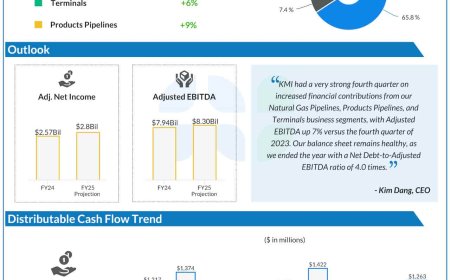Tech 5: Bitcoin Drops Below US$100,000, Micron Guidance Shakes Investors
Bitcoin surged early in the week before retracting below US$100,000, dampened by a hawkish rate cut from the US Federal Reserve that led to significant drops in both the crypto and stock markets.Meanwhile, the Nasdaq-100 (INDEXNASDAQ:NDX) welcomed three new companies, and artificial intelligence leader NVIDIA (NASDAQ:NVDA) lost ground to networking giant Broadcom (NASDAQ:AVGO).Find out what other key pieces of news made headlines in the tech space this week.1. Bitcoin drops below US$100,000 on Fed cutBitcoin surged above US$107,800 this past weekend, fueled by factors like MicroStrategy's (NASDAQ:MSTR) recent Bitcoin purchases, and anticipation of an interest rate cut from the Fed. Bitcoin historically performs well in December, and experts are saying that it's in "Santa Claus mode." Adding to the excitement, Strike CEO Jack Mallers hinted on Tim Pool's podcast that the US government may designate Bitcoin as a reserve asset through the Dollar Stabilization Act. Meanwhile, Digital Chamber founder Perianne Boring pointed to the stock-to-flow model on Fox Business, which predicts Bitcoin could hit US$800,000 by 2025's end.The cryptocurrency market kicked off the week at a market cap of US$3.9 trillion, up 0.3 percent in 24 hours.As open interest neared US$70 billion on Monday (December 16), traders eyed figures between US$120,000 and US$154,000 as Bitcoin’s next target based on bull flag pattern and Fibonacci extension analysis. Despite the bullish sentiment, Bitcoin experienced volatility on Tuesday (December 17). After retaking US$107,500 overnight and climbing to a new all-time high of US$108,135 following the opening bell, its price quickly sank below US$106,000, triggering around US$1.3 billion in liquidations.This brief pullback confirmed a resistance zone between US$108,000 and US$111,000. Rekt Capital attributed this retracement to a typical pattern seen during price discovery phases. Bitcoin's volatility continued into Wednesday (December 18), and it declined steadily before and after the Fed's meeting. The central bank announced a cut of 25 basis points as anticipated, but indicated that future reductions in 2025 may be less aggressive than initially projected. This shift in approach is attributed to recent economic data suggesting that the labor market is cooling and that inflation is stagnating above the Fed's 2 percent target. Chair Jerome Powell also asserted that the Fed is not allowed to own Bitcoin, potentially disrupting President-elect Donald Trump's plan to implement a strategic reserve when he takes office in January.This caused significant drops throughout the crypto market, with Bitcoin falling 3.75 percent in the two hours following Powell’s address. This was followed by further declines below US$100,000 on Wednesday evening.On Thursday (December 19), Bitcoin fell to an intraday low of US$95,700, and the market cap for the crypto sector was down by 6 percent after Wall Street markets wrapped. Ether and Solana recorded losses of over 10 percent, while XRP slid 8.5 percent, reversing gains from earlier in the week ahead of the launch of Ripple’s stablecoin, RLUSD. Losses extended into Friday morning, with Bitcoin dropping to US$92,245. The fall resulted in a bearish crossover, with over US$1 billion in liquidated positions, according to CoinGlass data. QCP Capital attributed the losses to overly bullish market positioning and the Fed's hawkish cut.After the dip, Bitcoin's price rebounded and held at around US$97,000 for most of Friday, a strong support zone identified by Glassnode founder Rafael Schultze-Kraft and Bitcoin researcher Axel Adler Jr. Recovery followed US personal consumption expenditures data that showed cooling inflation, easing investor concerns.2. Micron's quarterly guidance disappointsMicron Technology (NASDAQ:MU) delivered results for its first fiscal quarter of 2025 after Wednesday’s closing bell, showing an 84 percent year-on-year revenue increase for the period. “Data center revenue grew over 400 percent year over year and 40 percent sequentially, reaching a record level, with data center revenue mix surpassing 50 percent of Micron’s revenue for the first time,” the company said. However, its guidance for its second fiscal quarter indicates a downshift in sales.The company's Q2 revenue guidance is US$7.9 billion, missing analysts' expectations of US$7.93 billion. Non-GAAP earnings per share are anticipated to be US$1.26 compared to average projections of US$1.97.“While consumer-oriented markets are weaker in the near term, we anticipate a return to growth in the second half of our fiscal year,” wrote President and CEO Sanjay Mehrotra in a press release. “We continue to gain share in the highest margin and strategically important parts of the market and are exceptionally well positioned to leverage AI-driven growth to create substantial value for all stakeholders.”Shares of Micron opened 13.2 percent lower on Thursday morning and hit US$85 shortly after the market ope


Bitcoin surged early in the week before retracting below US$100,000, dampened by a hawkish rate cut from the US Federal Reserve that led to significant drops in both the crypto and stock markets.
Meanwhile, the Nasdaq-100 (INDEXNASDAQ:NDX) welcomed three new companies, and artificial intelligence leader NVIDIA (NASDAQ:NVDA) lost ground to networking giant Broadcom (NASDAQ:AVGO).
Find out what other key pieces of news made headlines in the tech space this week.
1. Bitcoin drops below US$100,000 on Fed cut
Bitcoin surged above US$107,800 this past weekend, fueled by factors like MicroStrategy's (NASDAQ:MSTR) recent Bitcoin purchases, and anticipation of an interest rate cut from the Fed.
Bitcoin historically performs well in December, and experts are saying that it's in "Santa Claus mode."
Adding to the excitement, Strike CEO Jack Mallers hinted on Tim Pool's podcast that the US government may designate Bitcoin as a reserve asset through the Dollar Stabilization Act. Meanwhile, Digital Chamber founder Perianne Boring pointed to the stock-to-flow model on Fox Business, which predicts Bitcoin could hit US$800,000 by 2025's end.
The cryptocurrency market kicked off the week at a market cap of US$3.9 trillion, up 0.3 percent in 24 hours.
As open interest neared US$70 billion on Monday (December 16), traders eyed figures between US$120,000 and US$154,000 as Bitcoin’s next target based on bull flag pattern and Fibonacci extension analysis.
Despite the bullish sentiment, Bitcoin experienced volatility on Tuesday (December 17). After retaking US$107,500 overnight and climbing to a new all-time high of US$108,135 following the opening bell, its price quickly sank below US$106,000, triggering around US$1.3 billion in liquidations.
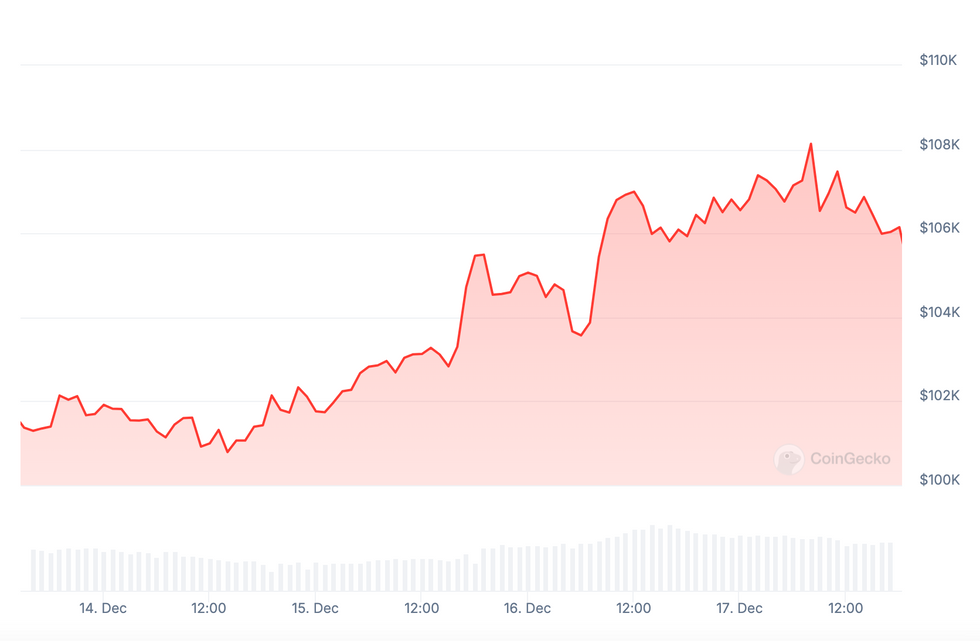
This brief pullback confirmed a resistance zone between US$108,000 and US$111,000. Rekt Capital attributed this retracement to a typical pattern seen during price discovery phases.
Bitcoin's volatility continued into Wednesday (December 18), and it declined steadily before and after the Fed's meeting. The central bank announced a cut of 25 basis points as anticipated, but indicated that future reductions in 2025 may be less aggressive than initially projected. This shift in approach is attributed to recent economic data suggesting that the labor market is cooling and that inflation is stagnating above the Fed's 2 percent target.
Chair Jerome Powell also asserted that the Fed is not allowed to own Bitcoin, potentially disrupting President-elect Donald Trump's plan to implement a strategic reserve when he takes office in January.
This caused significant drops throughout the crypto market, with Bitcoin falling 3.75 percent in the two hours following Powell’s address. This was followed by further declines below US$100,000 on Wednesday evening.
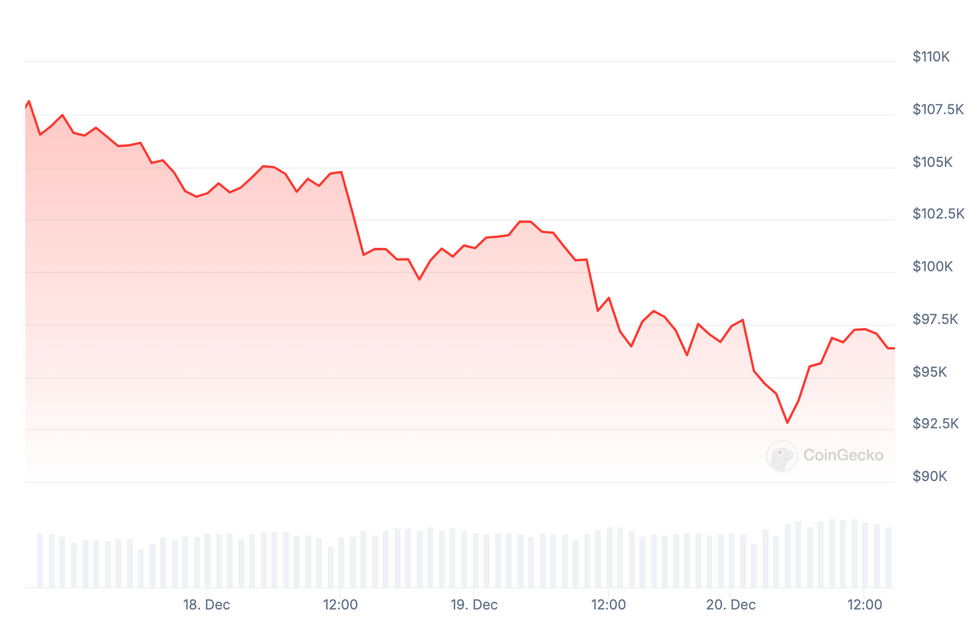
On Thursday (December 19), Bitcoin fell to an intraday low of US$95,700, and the market cap for the crypto sector was down by 6 percent after Wall Street markets wrapped. Ether and Solana recorded losses of over 10 percent, while XRP slid 8.5 percent, reversing gains from earlier in the week ahead of the launch of Ripple’s stablecoin, RLUSD.
Losses extended into Friday morning, with Bitcoin dropping to US$92,245. The fall resulted in a bearish crossover, with over US$1 billion in liquidated positions, according to CoinGlass data.
QCP Capital attributed the losses to overly bullish market positioning and the Fed's hawkish cut.
After the dip, Bitcoin's price rebounded and held at around US$97,000 for most of Friday, a strong support zone identified by Glassnode founder Rafael Schultze-Kraft and Bitcoin researcher Axel Adler Jr. Recovery followed US personal consumption expenditures data that showed cooling inflation, easing investor concerns.
2. Micron's quarterly guidance disappoints
Micron Technology (NASDAQ:MU) delivered results for its first fiscal quarter of 2025 after Wednesday’s closing bell, showing an 84 percent year-on-year revenue increase for the period.
“Data center revenue grew over 400 percent year over year and 40 percent sequentially, reaching a record level, with data center revenue mix surpassing 50 percent of Micron’s revenue for the first time,” the company said.
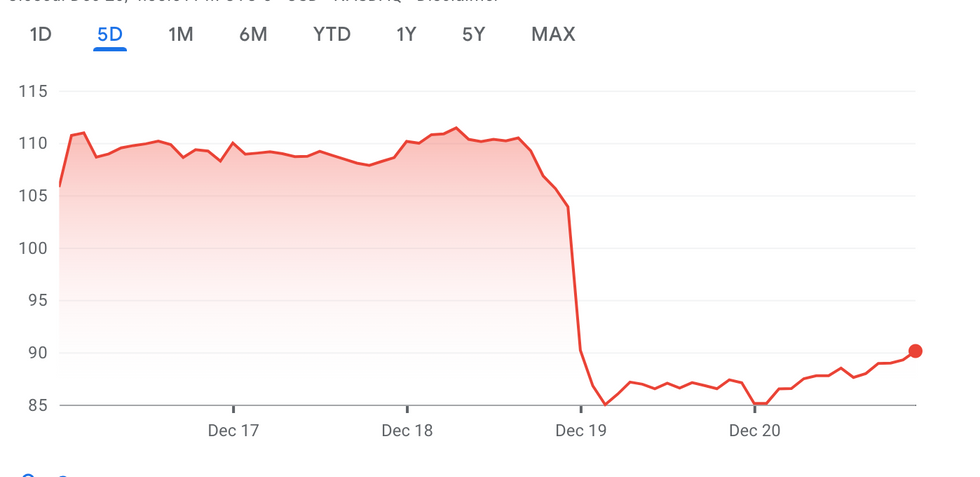
However, its guidance for its second fiscal quarter indicates a downshift in sales.
The company's Q2 revenue guidance is US$7.9 billion, missing analysts' expectations of US$7.93 billion. Non-GAAP earnings per share are anticipated to be US$1.26 compared to average projections of US$1.97.
“While consumer-oriented markets are weaker in the near term, we anticipate a return to growth in the second half of our fiscal year,” wrote President and CEO Sanjay Mehrotra in a press release.
“We continue to gain share in the highest margin and strategically important parts of the market and are exceptionally well positioned to leverage AI-driven growth to create substantial value for all stakeholders.”
Shares of Micron opened 13.2 percent lower on Thursday morning and hit US$85 shortly after the market opened. The company is ending the week down over 14 percent.
3. Broadcom surges as NVIDIA stumbles
Broadcom continued its upward trajectory this week, fueled by Friday's rally. It reached a valuation higher than even NVIDIA, which stumbled into correction territory on Monday.
After a mid-week bump ahead of the Fed's meeting, NVIDIA ultimately fell with the broader market as Powell signaled a hawkish stance, sinking further into correction territory.
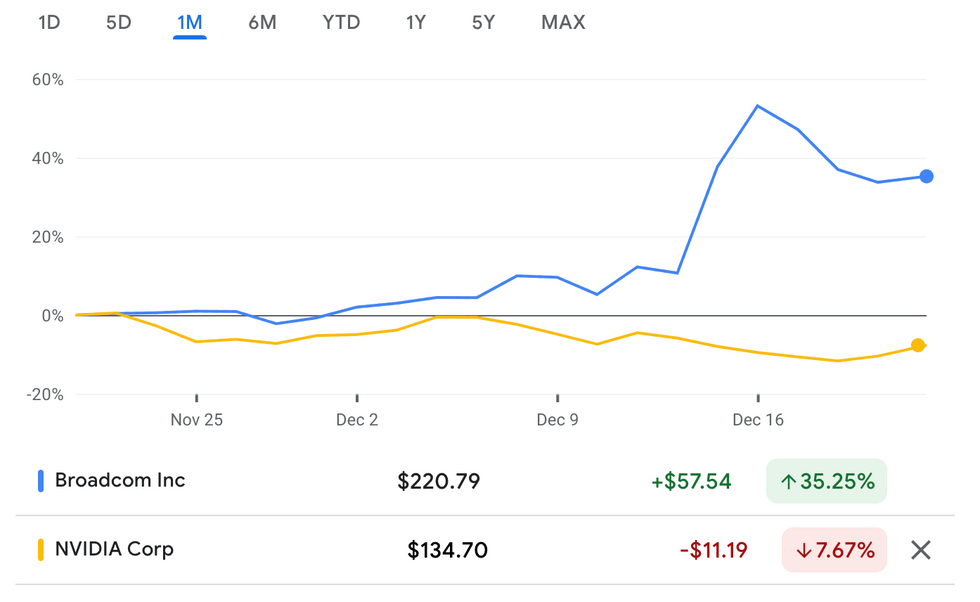
While NVIDIA remains a powerhouse with a stellar year overall, Broadcom's superior gains this month could signal a potential shift in the chip landscape, challenging NVIDIA's dominance.
Shares of NVIDIA were down 7.67 percent on the month as of Friday afternoon, while Broadcom had gained over 35 percent. Its share price rose by nearly 40 percent following the release of its earnings report last week.
Adding to NVIDIA's woes, reports suggest China is expanding its scrutiny of the company's acquisitions beyond the 2020 Mellanox deal, potentially casting a shadow over its future growth prospects.
4. Samsung, Texas Instruments finalize Chips Act deal
Samsung Electronics (KRX:5930) and Texas Instruments (NASDAQ:TXN) are the two latest companies to receive government funding via US President Joe Biden’s Chips Act initiative. The deals were finalized on Friday, with Samsung set to receive up to US$4.75 billion and Texas Instruments getting US$1.6 billion.
While Texas Instruments' final agreement aligns with an initial deal reached in August, Samsung's funding was significantly reduced. The company stated that it adjusted its investment plan to improve efficiency and that the incentives were determined through negotiations with the US government, but did not provide specific details.
Texas Instruments’ funding will go toward building new chipmaking facilities in Utah and Texas. They will reportedly create 2,000 new company jobs and thousands more employment opportunities in construction and supply management. Samsung will use its award to expand its facilities in Central Texas.
5. Palantir, Axon and MicroStrategy join Nasdaq-100
Nasdaq (NASDAQ:NDAQ) released its annual list of changes to the Nasdaq-100 on Monday, with data analysis and security companies Palantir Technologies (NASDAQ:PLTR) and Axon Enterprises (NASDAQ:AXON) joining the index, along with business intelligence and analytics software firm MicroStrategy.
Palantir secured multiple contracts with the US Department of Defense in 2024, while Axon landed a contract with the Canadian government to supply body-worn cameras to the Royal Canadian Mountain Police in November.
MicroStrategy has been in the news this year due to several Bitcoin acquisitions. Over the weekend, the company acquired another 15,350 Bitcoin for US$1.5 billion. The acquisition was finalized on Sunday (December 15), bringing the company’s total Bitcoin holdings to 439,000. The purchase was funded through share sales under the firm's at-the-market program. According to its latest filing, MicroStrategy now has US$7.65 billion remaining.
Bloomberg estimates that MicroStrategy's inclusion on the Nasdaq-100 will add at least US$2 billion in new stock purchases from the various exchange-traded funds that follow the index.
Super Micro Computer (NASDAQ:SMCI), on the other hand, saw its share price open over 14 percent lower on Monday following the news that it will be removed from the Nasdaq-100. It closed the week 0.85 percent higher.
Don't forget to follow us @INN_Technology for real-time news updates!
Securities Disclosure: I, Meagen Seatter, hold no direct investment interest in any company mentioned in this article.

